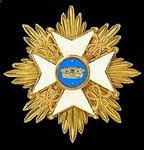
Most European nations at this time employed semi-invalid trained or veteran soldiers as garrison troops, to avoid having to use regular soldiers to do the job, but putting vital fortresses in the hands of troops whose capabilities, morale and motivation were sometimes suspect could be problematic. The Saxons had 8 companies of such troops and this appears to be the main uniform worn by most of them. As well as a musket and bayonet they carried a sabre with brass metalwork and a brown leather scabbard.
Saxon garrison troop numbers for September 1756 were: 3 companies as garrison at Wittenberg, 354 men; 1 company as garrison at Waldheim [in a grey uniform which I shall depict next], 176 men; 1 company as garrison at Pleissenberg, 115 men; the garrison at Königstein, 195 men; and the garrison at Sonnenstein, 125 men. All these were gathered in to the fortified Camp at Pirna with its Sonnenstein Fortress and which also included the Königstein citadel, along with most of the Saxon army. Unfortunately, from the beginning the plan was botched as equipment, ammunition and food and fodder were in short supply and the Prussian hussars quickly prevented any sorties to acquire more food and fodder. The fortresses were also in a poor state and so the garrisons (who were weak in numbers and condition) were all gathered into the fortress of Königstein, with a newly-arrived Anhalt free company from Wittenberg stationed in Pirna town and Sonnenstein.The camp simply became a large prison camp for the Saxon forces and Frederick wisely kept them bottled up without any attempt to storm it, which would probably have been suicidal, given the difficulty of the terrain. The Saxon army, after an abortive breakout attempt, surrendered on the 16th October to avoid starving to death. The garrison of Königstein (which included the men from Sonnenstein) was the only unit exempted from the surrender and the fortress of Königstein was declared neutral for the duration of the war; the Saxon army's colours and standards were placed there and not taken as trophies of war, the only concession that Frederick made to the Saxons. The other garrison troops were forcibly enlisted in the Prussian army along with the rest of the Saxon units. The cavalry were distributed amongst the Prussian cavalry and the Saxon infantry formed into 10 new infantry regiments. Within months all but 3 of those infantry units had been disbanded because of desertions; many of the Saxon deserters joined the Austrians or the French to continue their war against Frederick, who seems to have had a personal grudge against all things Saxon.
I am grateful to Stefan Schulz for translation work on Francke and Schuster's book of 1885 on the history of the Saxon army and for details from Markus von Salisch: "Treue Deserteure. Das kursächsische Militär und der Siebenjährige Krieg", Munich (Oldenbourg) 2009 - ISBN 978-3-486-58805-7.
 The Saxon Invalid or Garrison Company of Waldheim, 176 strong in September 1756, was one of the garrison units captured at Pirna (see previous entry). Waldheim is an attractive small town with a castle and former monastery in central Saxony, rather knocked about in the 30 Years War, sacked and pillaged by the Prussians in 1761 and also the scene of some activity in the Napoleonic Wars, when it was occupied by the French and the bridge destroyed.
The Saxon Invalid or Garrison Company of Waldheim, 176 strong in September 1756, was one of the garrison units captured at Pirna (see previous entry). Waldheim is an attractive small town with a castle and former monastery in central Saxony, rather knocked about in the 30 Years War, sacked and pillaged by the Prussians in 1761 and also the scene of some activity in the Napoleonic Wars, when it was occupied by the French and the bridge destroyed.



















